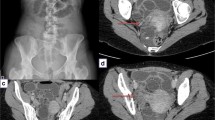Summary
Traditionally, the linea alba represents the principal route of approach in abdominal surgery and in consequence it is the commonest site of incisional hernia. The aim of this study was to review its morphology and to study its mechanical parameters of resistance, deformation and elasticity in order to compare these with the prosthetic materials most often used in the treatment of incisional hernia. Forty fresh cadavers were dissected and tests with a dynamometer and “bursting strength tester” were performed on samples taken from the linea alba at three leveels: supra-umbilical, subumbilical and umbilical. Forty abdomino-pelvic scans were analysed. The morphologic results allowed definition of diastasis of the rectus mm. in terms of subject age: below 45 years of age diastasis was considered as a separation of the two rectus mm. exceeding 10 mm above the umbilicus, 27 mm at the umbilical ring and 9 mm below the umbilicus; above 45 years of age the corresponding values were 15 mm, 27 mm and 14 mm respectively. In the biomechanical study the subumbilical region exhibited a coefficient of elasticity greater than that of the supra-umbilical portion, but no significant difference in resistance was found between the different parts studied. The biomechanical results are compared with the corresponding data for prosthetic materials.
Résumé
La ligne blanche représente la principale voie d'abord en chirurgie abdominale traditionnelle et, par conséquent, le siège le plus fréquent des éventrations abdominales. Le but de ce travail était de réviser sa morphologie et d'étudier ses paramètres mécaniques de résistance, de déformation et d'élasticité, afin de les comparer à ceux des matériaux prothétiques les plus souvent utilisés dans les cures d'éventration. Quarante cadavres frais ont été disséqués, et des tests au dynamomètre et à l'éclatomètre ont été pratiqués sur des échantillons prélevés dans la ligne blanche à trois niveaux: supra-ombilical, infra-ombilical et au niveau de l'ombilic. Quarante scanners abdomino-pelviens ont été analysés. Les résultats morphologiques permettent de définir le diastasis des muscles droits en fonction de l'âge des sujets : en-dessous de 45 ans sera considéré diastatique un écart entre les deux muscles droits supérieur à 10 mm en supra-ombilical, 27 mm au niveau de l'anneau ombilical et 9 mm en infra-ombilical; au-delà de 45 ans les valeurs seront de 15 mm, 27 mm et 14 mm respectivement. Quant à l'étude bio-mécanique, la région infraombilicale présente un coefficient d'élasticité supérieur à celui de la portion supra-ombilicale, mais aucune différence significative de résistance n'a été retrouvée entre les différentes portions étudiées. Les résultats bio-mécaniques sont comparés aux données correspondantes aux matériaux prothétiques.
Similar content being viewed by others
References
Bouyssy A, Davier M, Gatty B (1988) Physique pour les sciences de la vie, vol 2, Chap 19. Tardy Quercy, pp 212–220
Lliboutry L (1960) Physique de base pour biologistes, médecins et géologues. Masson, Paris
Neidhart JPH (1994) Les muscles de l'abdomen. In: JP Chevrel (ed) Le Tronc. Anatomie Clinique. Springer, Paris Berlin Heidelberg, pp 93–122
Paturet G (1951) Aponévroses de l'abdomen. In: Traité d'Anatomie Humaine, Masson, Paris, pp 903–914
Poirier P, Charpy A (1912) Aponévroses de l'abdomen. In: Traité d'Anatomie Humaine, Masson, Paris, pp 336–380
Rath AM, Zhang J, Amouroux J, Chevrel JP (1996) Les prothèses pariétales abdominales: étude bio-mécanique et histologique. Chirurgie 121: 253–265
Rouvière H (1939) Anatomie générale. Origine des formes et des structures anatomiques. Masson, Paris, pp 63–76
Rouvière H (1967) Anatomie humaine. Masson, Paris, pp 80–84
Yamada H (1970) In: F Gaynor Evans (ed) Strength of biological materials. Williams & Wilkins, Baltimore
Author information
Authors and Affiliations
Rights and permissions
About this article
Cite this article
Rath, A., Attali, P., Dumas, J. et al. The abdominal linea alba: an anatomo-radiologic and biomechanical study. Surg Radiol Anat 18, 281–288 (1996). https://doi.org/10.1007/BF01627606
Received:
Accepted:
Issue Date:
DOI: https://doi.org/10.1007/BF01627606




